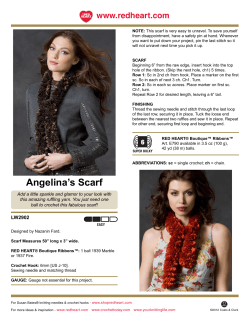
Document 89282
Frankie’s Knitted Stuff Ten Stitch Zigzag This technique consists of knitting ten stitch wide garter stitch strips which zigzag due to regular increases and decreases. The strips are joined as you go so there is no sewing up and, as the knitting is turned over at the end of each strip, the resulting fabric is completely reversible. Any yarn and needles can be used to knit either a blanket as I have done or try working fewer, longer strips for a scarf. This pattern would also be good for using up leftovers as each strip could be worked in a different yarn. The pattern is not as complicated as it looks and, because it is worked in small pattern repeats, it doesn’t get boring. I enjoyed knitting this more than any of my other Ten Stitch patterns. My Blanket I knitted my blanket in Rico Poems (100m / 50g), shade 005, on 4.5mm / US size 7 needles. It measures about 122cm x 89 cm / 48" x 35" and used approximately 15 balls of wool. Some Things to Remember A ridge in garter stitch consists of two rows. Throughout this pattern I shall refer to ‘zigs’ and ‘zags’. The right hand edge of the strip being knitted increases for a zig and decreases for a zag. One zig and one zag make a zigzag! Although the pattern is simple to learn, it can be easy to miscount or to work the wrong number of ridges. Check your number of stitches regularly, you should always have 10 sts on the needle at the end of a ridge. To keep track of the number of ridges worked I put a safety pin in the knitting as I started each zig or zag and then counted the ten ridges from that. The First Strip Cast on 10 sts. Row 1: Row 2: Kf&b, K7, K2tog. Knit. Work these two rows ten times, ten ridges in all. Now work the following two row pattern for the next ten ridges. Row 1: Row 2: Knit. Kf&b, K7, K2tog. This will give you your first zigzag as shown in the picture. For the first ten ridges the right side increases (the zig) and for the second it decreases (the zag). Continue working alternate zigs and zags as described above until this strip is as long as you want it to be. I worked eight complete zigzags in all. On the last zag work only 9 ridges in pattern before working the turn to start the next strip. In the pictures illustrating the following instructions you will notice that I have already worked several strips but the instructions for turning and joining strips are the same whether you have worked one strip or twenty. The Turn Next row: Knit. Now cast off 9 sts, leaving you with just one stitch on the needle. Turn the work so that you are ready to start working back along the strip. Begin the next strip by casting on 9 sts to get back to the original 10. From now on the strips have to be joined on to the previous strip as well as shaped. This joining is done at the end of the first row of each ridge by slipping the last stitch of the row knitwise, picking up and knitting a stitch from the end of the next ridge on the previous strip and then passing the slipped stitch over. This is the same join as that used in my other Ten Stitch patterns although the second rows are different. Joining a Zig Work 10 ridges in the following two row pattern: Row 1: Row 2: Kf&b, K8, sl 1 kwise, pick up and K1, psso. P2tog, K9. Joining a Zag Work 10 ridges in the following two row pattern: Row 1: Row 2: K9, sl 1 kwise, pick up and K1, psso. P1, kf&b, K6, K2tog. Carry on across the strip in this way. This method of joining will give you a neat raised edge on the right side but, as the work is turned over at the end of each strip, the right side changes so you will have a raised edge on every other strip on both sides of the finished piece. Turning a Joined Strip The turn at the end of a joined strip is worked in a similar way to that on the first strip. Work 9 ridges of the final zag pattern. Next row: K9, sl 1 kwise, pick up and K1, psso. Now cast off 9 sts, leaving you with just one stitch on the needle. Turn the work and cast on 9 sts. You are now ready to start the next strip. That’s it really. Just carry on until your blanket is big enough or you run out or yarn and finish by casting off all the 10 sts instead of just 9 at the end of a strip. The edge of the blanket will not be completely straight as you can see. I found that blocking improved this but you might like to add an I cord or crochet edging if this bothers you. Before Blocking After Blocking Abbreviations st / sts K P kf&b K2tog P2tog sl 1 kwise psso stitch / stitches knit purl knit into the front and back of the stitch knit 2 stitches together purl 2 stitches together slip 1 stitch knitwise pass slipped stitch over © Frankie Brown, 2010. My patterns are for personal use only and should not be used to knit items for sale.
© Copyright 2025





















